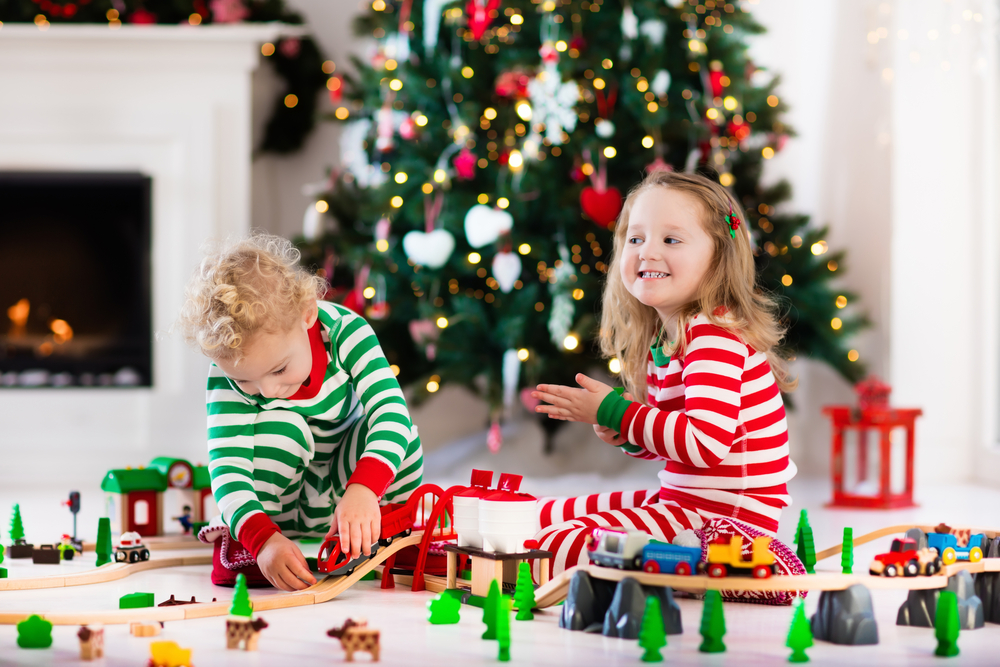
Full disclosure, I own a toy store… and I’m going to tell you to tame the toy monster that is taking over your home. Why? Because I know that toys are essential to a child’s development (and an adult’s lifelong health) and the right toys and right types of play are crucial to physical, mental, and emotional intelligence. I also know that once you’ve stepped on a LEGO for the 100th time, or you can’t find your child in the morning because their bed is so full of stuffed animals, the idea of an influx of new toys (hello, holidays!) can feel overwhelming.
Face the Facts About Toy Clutter
I’m here to help you cut the toy clutter, but first, we have to face some facts:
The kids in your life probably do have too many toys. Where do these toys even come from? One minute, the playroom is Pinterest-worthy, and the next minute an avalanche of toys has fallen, and — oh no!! Where is the dog?!? Maybe that’s a little extreme, but if children cannot get to their toys easily or are unable to find all the parts they need to enjoy a toy, they really are just taking up space and making it harder to have fun. It is easy to get sentimental about toys, and quickly, they will overrun our lives if not kept under control.
You’re going to buy them toys anyway. Many of the best childhood memories center around toys, especially holiday memories. There’s something so magical about a child dreaming, asking Santa, and unwrapping a special surprise on Christmas morning. Plus, don’t we have children around as an excuse to play with their toys? Less new toys for them means less new toys for you, too!
5 Ways to Cut Down
Here are a few easy things you can do to cut down on toy clutter, without denying your kids (or yourself):
1. Get rid of some toys. Let’s start with the obvious. There are toys they begged for and never played with, kids’ meal trinkets, school prizes — go through them BEFORE Santa’s elves show up. Different children require different approaches to this task. A quick Google search will give you lots of ideas to help get children on board with making room — everything from learning to “share” by donating them, to slowly sneaking them out of the house. You know your child best, so only you know the most painless way to do this — but it has to be done. When toys are organized and easy to find, children don’t feel overstimulated or overwhelmed and have an easier time playing independently.
2. Pay attention. With media (and commercials) now being everywhere, what your child asks for and what your child will actually love are likely two very different things. Remember that toy they begged for and never played with? Marketers are very savvy and spend a lot of time and money to influence children. Instead, notice the toys that your child goes to over and over (you know, the ones you step on every day) and take note of what those toys have in common. Different developmental stages also call for different types of toys. Meet your child where they are — your 3-year-old might be begging for magnetic Thinking Putty, but developmentally they are not ready to play with it responsibly and the ensuing mess would frustrate both the caregiver and the child. Always look for toys that a child can easily play with little adult interference — this will foster independence and confidence.
3. Go for open-ended toys. We have a saying at our toy store, “The less it does, the more a child can do with it.” The more ways in which a child can play with a toy, the longer it will keep their attention. Toys that do everything for the child are only fun until the novelty wears off. There’s a reason that kids love cardboard boxes so much — they can be anything! Timeless toys like blocks, puppets and art supplies will always surpass trendy gadgets when it comes to their ability to last, both in durability and in holding a child’s interest. Additionally, beware of toys that give your children little to do other than collect more… these tend to be the most heavily marketed toys because they can be the most lucrative for corporations.
4. Look for add-ons. Take stock of the child’s favorite toys — are there things you can buy that will enhance that toy’s play value? Adding on to toys you already own is economical and also saves you space. Think clothes for a favorite doll, more figures for a favorite set, or additional parts for a favorite construction toy.
5. Make a wish list. Most major retailers and even a lot of family-owned businesses offer a wish list option on their websites. Don’t be afraid to make and share a list — wish lists can help friends and family accomplish their ultimate gift-giving mission: to get them something they absolutely love!

















If I lived near you I would totally be a devoted customer just because you named a store on Amelia Island, “Villa Villekulla.”